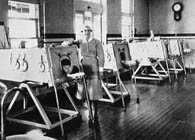
Both respirator
1937
movable respirator for people with polio
Poliomyelitis is inflammation of the nerve cells which leads to paralysis. In the past many polio patients died because their chest muscles were paralysed and they couldn't breathe. The cast-iron breathing cabinet or 'iron lung' (invented in America in 1927) saved lives, but it was complicated, expensive and so heavy that floors needed to be reinforced to support it.
During a polio epidemic in South Australia in 1937, Edward and Donald Both (pronounced like 'moth') built a cheap, lightweight plywood cabinet respirator at their small Adelaide factory. As the cabinet and electric air pump were easy to move, people who needed constant breathing assistance could move out of hospital and back to their homes.
A vaccine against polio was developed in 1954 and the demand for respirators dropped. Today, although there are much smaller respirators, some polio survivors still prefer to use their Both.
Some people who recover from childhood polio experience a relapse of their symptoms in old age called post polio syndrome. In the USA, small plastic portable respirators that look like tortoise shells are now helping people breathe.
Who Did It?
Key Organisations
Both Equipment Ltd : development, manufacture
Morris Motors Ltd (UK) : manufacture, distribution
Drug Houses of Australia Ltd : distribution
Key People
Edward Both : inventor
Donald Both : collaborator
Further Reading
Making it: innovation and success in Australia's industries
R Renew
Powerhouse Publishing, Sydney, 1993, p 50.
Links
Both mechanical respirator video
|










